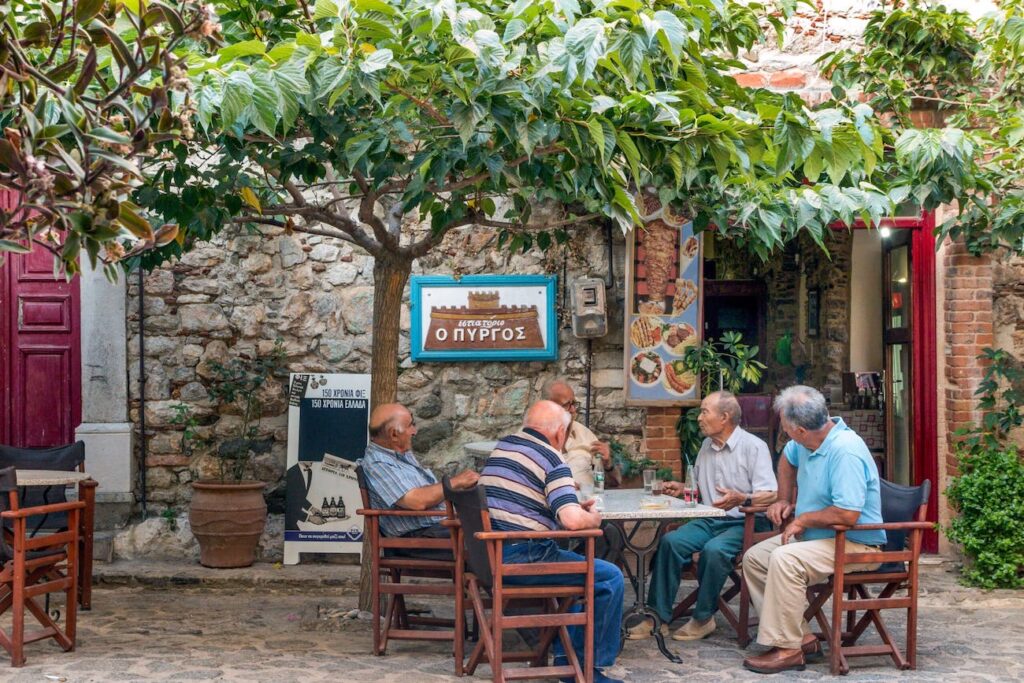You haven’t truly experienced Greece until you’ve sat in a traditional “kafeneion” (coffee shop). In Greece, coffee shops are more than just a quick stopping point. Unlike the “to go” culture in many western countries, a kafeneion is a place to slow down and enjoy time with others. A coffee is not just a beverage or a “shot of energy” like in other countries. It represents a lot more, especially for foreigners visiting for the first time. A Greek coffee is one of the first signs of hospitality to a foreigner, and it often leads to a meal, a new relationship, a heated discussion, or a lifelong friendship.

What Can I Expect in a Greek Coffee Shop?
In a coffee shop in Greece, the locals have a way of finding out everything about you, and they ask many questions. Greeks are naturally curious in this way. They might ask where you are from, what you are doing in Greece, and where you will travel next. You will likely be asked very direct questions about your marriage status, your politics, and your religious beliefs.
The kafeneion is also a place where you can get advice on just about anything, or to find anybody you need. Also, if you are new to a region, you can learn what places in the area there are to explore.

The History of Greek Coffee Shops
In the past, traditional coffee shops in Greece and served as barbershops, shoe stores, and butcher shops. Today, some coffee shops are grocery stores. More than just coffee is on the menu – political and social topics will come to the table, and likely a glass of the local alcohol, like tsipouro or raki.
Historically, the kafeneion was a place for men – they would come to drink, chat, and relax. You are likely to witness a group of men playing backgammon or cards for hours. Women could come as well, of course. But it was more common for men to hang out here. The oldest kafeneion in Greece is found in Lafkos village in South Pelion, and it is almost 250 years old.

Where Can I Find a Traditional Greek Coffee Shop?
You will find a coffee shop in every village in Greece. If you are in a larger city like Athens or Thessaloniki, western influence has also brought coffee chains, like “Mikel” and “Coffee Island”. These stores are great to grab a quick to-go snack, but if you want the true experience, look for signs that read “καφενείο”, which sometimes have a chalkboard outside with a menu. Apart from Greece’s smallest villages, each town usually has at least two coffee shops. This is because there may be local sports or political rivalries which divide the locals into different areas.

Cretan Coffee Shops
In some Cretan coffee shops, you are not allowed to leave until you are “olomethystos” – in other words, you are drunk. Sitting in a Cretan kafeneion, you historically could find out everything you needed to know, like who was out working the fields, who had died, and who was about to get married. The longer you stay, the more likely you are to enjoy some “meze” – small plates with local specialties like smoked “apaki” pork or Cretan “dakos” salad, almost always with a healthy amount of Greek olive oil.

Coffee Culture in Greece
Greece’s coffee culture comes from Ottoman times, when Greece was part of the Ottoman Empire. The traditional “Greek coffee” – a dense, strong shot of espresso served in a tiny cup – likely became popular in the early 19th century. It contrasts with coffee culture in Italy, where you find cafe bars and customers standing to drink their coffee.
In Greece, there are always tables in coffee shops, and a cup of coffee with friends can sometimes last for hours. Usually, the first thing you do with a new friend or acquaintance — whether romantic or platonic — is to go for a coffee. Although the typical invitation is “πάμε για καφέ” (let’s go for coffee), it doesn’t necessarily mean you need to order coffee. Tea and other drinks are available. Order with a smile, and you just might find a traditional local dessert on your plate as well!









